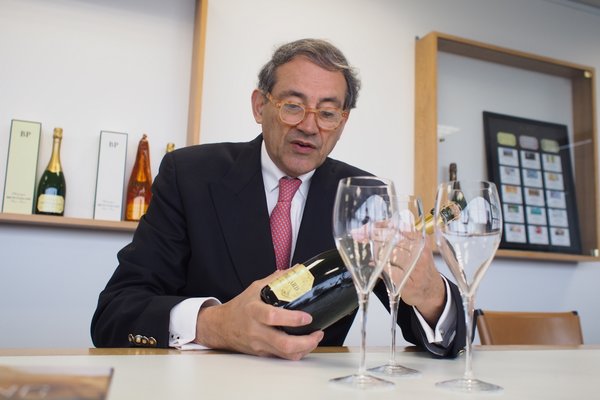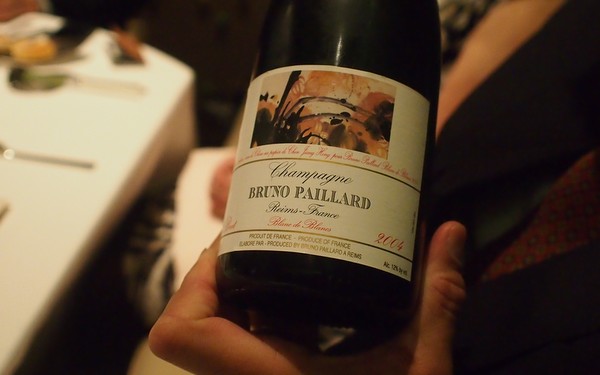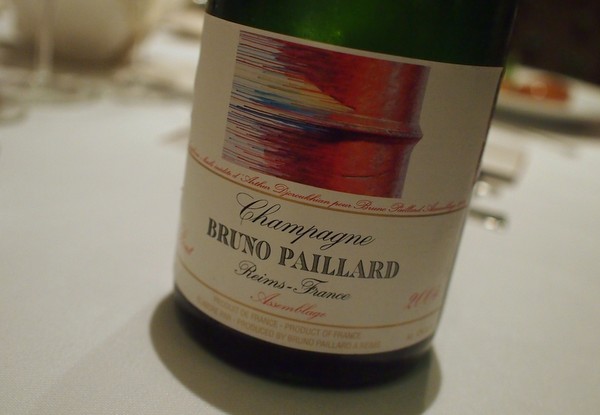|
Champagne
Bruno Paillard
Meeting the man who started his own Champagne house

Back in 1981, Bruno Paillard did
something unusual, and ambitious. He started a new Champagne house.
'I was 27 and not very conscious of the difficulties,' he says. 'It
is the kind of thing you don't do when you are older.'
He sold his Mark II Jaguar for 50 000
Francs (around £5000 at the time), and this formed the working
capital of the company. He borrowed money from the bank and bought
some grapes, renting winery space to process them.
Bruno Paillard had been working for six
years for his father's grape broking company, and this gave
him the inside knowledge he needed to get hold of the right
sort of grapes at the right price. 'I selected good grapes from
interesting places where I would work with the particular minerality
of chalk sub soils,' he says.

'The environment of Champagne was
changing a lot at the time,' Paillard recalls. In the 1970s many
family businesses had been sold to big groups. There was less family
involvement, and at the same time interest rates were very high.
According to Paillard, this led to the emergence of managements who
were very finance orientated, and this in turn led to changes in the
flavour of the wines.
They were made quicker using more
oxidative processes, and the dosages were too high. Also, at the
time there was the emerging power of the supermarkets, which changed
the way Champagne was distributed. Paillard thinks the wines began
to look similar, and communication from the houses became
fashion-oriented rather than about the wines.
'Those who chose this way were right
economically,' he notes, 'but I had a more romantic view of
Champagne.'
'I chose the opposite road,' says Paillar.
'A family-owned house, practicing long maturation, using low dosage,
and choosing selective distribution.' This is how Champagne Bruno
Paillard was born.
It is, he claims, unique among Champagne
houses, in that his name is on the bottle, he is the owner, and he
creates the blends.
'I am not the winner,' he says, 'but I
have shown that it is possible to take the north face road that
reflects the truth of Chamapgne, the truth of terroir.'
He reckons that they are ranked around 30
in terms of size of Champagne house, with a production of just under
500 000 bottles annually. The non-vintage wines have a high
proportion of reserve wine in them, ranging from 28 to 50%.
Although Paillard uses a low dosage, he's
no fan of zero dosage/non-dosage Champagnes. 'The category is dead,'
he says. 'It was killed by growers' Champagnes released far too
young. Customers didn't like it and I am not sure that I like it.'
But because of his emphasis on
controlling distribution (to high-end restaurants and specialist
wine shops), he supplies around 420 Michelin-starred restaurants,
which is remarkable given the size of production.
In terms of style, he aims at 'purity,
minerality and ageing capacity.' Just first pressings are used and
Paillard targets vineyards that have chalky subsoils. The cellar has
110 steel tanks and also 500 barrels, which are bought second-hand
from Denis Dubordieu and the Perrin family in Bordeaux.
Paillard designed a special bottle shape.
This is because he had previously worked as a broker, and he wanted
to make it clear that he wasn't buying sur latte, a practice he
strongly disagrees with (this is when a Champagne house buys wines
in bottle from other sources and then disgorges them and puts their
own label on them). However, his bottle shape – he feels – was
recently copied by a well known Champagne house, something which he
is furious about but thinks there is no point in legal action.

I asked about RD (recently disgorged)
Champagnes, and soon wished I hadn't. 'Are you provoking me?' was
the response. 'Old wines tasted soon after disgorgement don't work,'
says Paillard. He likens the disgorgement procedure to surgery. You
survive surgery better if you are young than if you are old, and you
need a long time to recover from surgery. 'The longer on the lees,
the longer is needed after disgorgement.'
Champagne Bruno Paillard is 100% family
owned, and there is a succession plan: his daughter Alice is taking
over from him. She is now the main shareholder and is the future
CEO.
THE
WINES
Champagne Bruno Paillard Blanc de
Blancs Grand Cru NV France
Bruno Paillard describes this as 'a concentration of our
philosophy', and says 'you can almost smell the saltiness of the
chalk.' It spends a minimum of 4 years on its lees. Mainly Le Mesnil
and Oger, with some Cramant, Chouilly and Avize.Very precise, with
pure lemony fruit. Lovely precision and purity. Tight and lemony,
with potential for development. Serious. 94/100
Champagne Bruno Paillard Blanc de
Blancs 2004 France
From a classic vintage. Some toast and ripe almond notes, as
well as a bit of honey, but the dominant theme is the fresh,
citrussy fruit. Lively and pure with good acidity and fine
toastiness. 94/100
Champagne Bruno Paillard Assemblage
2004 France
Tight and precise with citrus, some toasty richness and good
structure. Fine and expressive with lovely pure citrus fruits.
Precision as well as texture here. 94/100
Champagne Bruno Paillard Rosé Première
Cuvée NV France
This is 20% of production, although only 8% of Champagne sold
globally is rosé. Pale colour. Very fine, pure and fresh, with
subtle cherry and strawberry fruit, and nice acidity. Lovely finesse
and purity, which Bruno says can only be achieved by assemblage, not
saignee. 92/100
See
also:
 Taittinger
Comtes de Champagne Vertical Taittinger
Comtes de Champagne Vertical
 Champagne
Philipponnat Champagne
Philipponnat
Wines
tasted 10/13
Find these wines with wine-searcher.com
Back
to top
|

